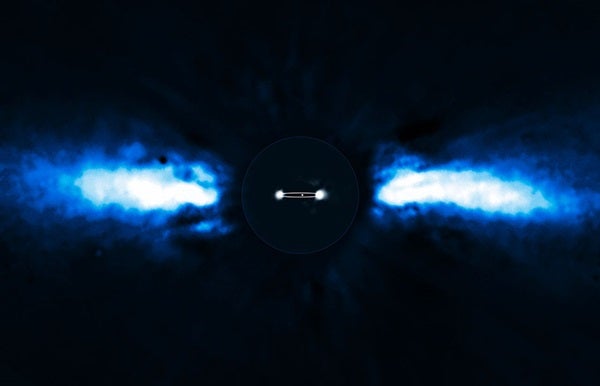For the first time, astronomers have been able to directly follow the motion of an exoplanet as it moves from one side of its host star to the other. The planet has the smallest orbit so far of all directly imaged exoplanets, lying almost as close to its parent star as Saturn is to the Sun. Scientists believe that it may have formed in a similar way to the giant planets in the solar system. Because the star is so young, this discovery proves that gas giant planets can form within disks in only a few million years, a short time in cosmic terms.
Only 12 million years old, or less than three-thousandths of the age of the Sun, Beta Pictoris is 75 percent more massive than our parent star. It is located about 60 light-years away toward the constellation Pictor the Painter, and it is one of the best-known examples of a star surrounded by a dusty debris disk. Earlier observations showed a warp of the disk, a secondary inclined disk, and comets falling onto the star. “Those were indirect, but telltale signs that strongly suggested the presence of a massive planet, and our new observations now definitively prove this,” said Anne-Marie Lagrange from Laboratoire d’AstrOphysique de Grenoble (LAOG), France. “Because the star is so young, our results prove that giant planets can form in disks in time spans as short as a few million years.”
Recent observations have shown that disks around young stars disperse within a few million years, and that giant planet formation must occur faster than previously thought. Beta Pictoris is now clear proof that this is possible.
The team used the NAOS-CONICA instrument (NACO) mounted on one of the 8.2-meter Unit Telescopes of the European Southern Observatory’s (ESO) Very Large Telescope (VLT) to study the immediate surroundings of Beta Pictoris in 2003, 2008, and 2009. In 2003, a faint source inside the disk was seen, but it was not possible to exclude the remote possibility that it was a background star. In new images taken in 2008 and spring 2009, the source had disappeared. The most recent observations taken during autumn 2009 revealed the object on the other side of the disk after a period of hiding either behind or in front of the star (in which case it is hidden in the glare of the star). This confirmed that the source was an exoplanet and that it was orbiting its host star. It also provided insights into the size of its orbit around the star.
Images are available for approximately 10 exoplanets, and the planet around Beta Pictoris — designated “Beta Pictoris b” — has the smallest orbit known so far. It is located at a distance between 8 and 15 times the Earth-Sun separation — or 8 to 15 astronomical units — which is about the distance of Saturn from the Sun. “The short period of the planet will allow us to record the full orbit within maybe 15 to 20 years, and further studies of Beta Pictoris b will provide invaluable insights into the physics and chemistry of a young giant planet’s atmosphere,” said Mickaël Bonnefoy from LAOG.
The planet has a mass of about 9 Jupiter masses and the right mass and location to explain the observed warp in the inner parts of the disk. This discovery therefore bears some similarity to the prediction of the existence of Neptune by astronomers Adams and Le Verrier in the 19th century, based on observations of the orbit of Uranus.
“Together with the planets found around the young, massive stars Fomalhaut and HR8799, the existence of Beta Pictoris b suggests that super-Jupiters could be frequent byproducts of planet formation around more massive stars,” said Gaël Chauvin from LAOG.
Such planets disturb the disks around their stars, creating structures that should be readily observable with the Atacama Large Millimeter/submillimeter Array (ALMA), the revolutionary telescope being built by ESO together with international partners.
A few other planetary candidates have been imaged, but they are all located farther from their host star than Beta Pictoris b. If located in the solar system, they all would lie close to or beyond the orbit of the farthest planet, Neptune. The formation processes of these distant planets are likely to be quite different from those in our solar system and in Beta Pictoris.
“The recent direct images of exoplanets — many made by the VLT — illustrate the diversity of planetary systems,” said Lagrange. “Among those, Beta Pictoris b is the most promising case of a planet that could have formed in the same way as the giant planets in our solar system.”










